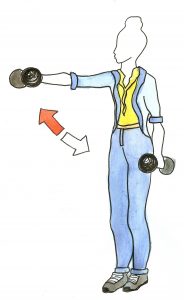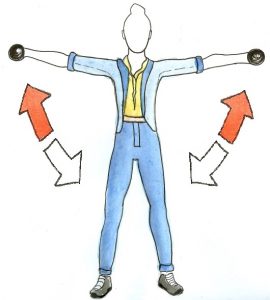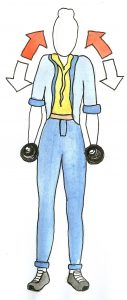Four Effective Strategies to Relieve Neck Pain from Screen Use | Simple Tips for Long-Term Comfort
Searching for Neck pain relief from excessive screen time is common. The good news is, it doesn’t have to be permanent, thanks to simple preventive exercises. Learn 4 simple and effective ways to relieve neck discomfort, improve posture, and keep your neck healthy for the long term.
Why Neck Pain is on the Rise
Our increasing use of computers and screens has led to increasing levels of neck pain. The forward neck posture once associated with aging is now common. In  fact, “children as young as 15 have shown posture-related early arthritic changes on x-rays”[1].
fact, “children as young as 15 have shown posture-related early arthritic changes on x-rays”[1].
MSD’s (i.e. musculoskeletal disorders) and soft tissue injuries are recognized as the most significant negative health issues associated with the use of personal computers [2, 3], and are considered a major contemporary occupational health problem [4].
Managing discomfort and minimising the chance of injury is not simple. Multiple risk factors work independently and accumulatively, so it’s important to think holistically about management strategies. No one treatment or recommendation guarantees a fix that works for everyone.
Four interventions are commonly recommended as part of a normal work routine; implementing ergonomics recommendations at your workstation, ensuring adequate stretching and breaks between periods of work, regular aerobic exercise, and strengthening exercises for the neck and shoulders.
After a brief overview of interventions, this article focuses on the strengthening exercises recommended for reducing the neck pain associated with screen use.
4 Ways to Relieve Neck Pain from Screen Use
Consider four interventions when working to minimise screen-related neck pain.
- Implement Ergonomic Workstation Adjustments – How to set up equipment to avoid working in awkward postures that may lead to discomfort or injury.
- For the WorkSafe Ergonomic guide Click Here
- Take Regular Breaks and Stretch – Designed to release tension and allow recovery time between periods of work. Completing stretches when you feel the tension is important, however, results are significantly improved when these are completed 3 times a day.
- Download our Illustrated Stretch Guide: Click Here
- Engage in Aerobic Exercise – A trial of aerobic exercise as a treatment for persons suffering from migraine and co-existing tension-type headache and neck pain was found to significantly reduce migraine frequency, pain intensity and duration, and neck pain intensity[5].
- Exercises used in this example: bike/cross-trainer/brisk walking for 45 minutes, three times/week.
- Always get professional advice if you have not exercised regularly for an extended period. Your body changes…It’s just the way it is!
- For the Australian Government “Make A Move” Campaign Click Here
- Exercises used in this example: bike/cross-trainer/brisk walking for 45 minutes, three times/week.
- Strengthen Your Neck and Shoulder Muscles – a targeted program to strengthen the muscles of the neck and shoulders girdle.
Focus on Strength
While the dominant approach to relieving neck pain is an ergonomic adjustment, if not matched by the right work behaviours, these adjustments do not guarantee relief. The following recommendations reported in Liam Mannix’s December 2017 article in The Age newspaper shows
“Only one thing worked consistently: a targeted program to strengthen the muscles of the neck, shoulders and back.”
The Recommendations
Think – Raise, Fly, Shrug
To beat tech neck (forward neck posture), the research team recommends four exercises. The front raise, side raise, reverse fly and shrug. Ultimately you should aim for a 20-minute session, three times a week, over a period of at least 10 weeks.
 Front Raise: With elbows slightly flexed, raise one arm at a time to shoulder height directly in front of you.
Front Raise: With elbows slightly flexed, raise one arm at a time to shoulder height directly in front of you.
Lateral Raise: With elbows slightly flexed lift both arms out to shoulder height.
 Reverse Flies: Sit bent over forward with back straight. Let your arms hang straight down, then raise to shoulder height.
Reverse Flies: Sit bent over forward with back straight. Let your arms hang straight down, then raise to shoulder height.
Shrugs: While standing, let your arms hang by your side. Then lift both shoulders as high as possible.
How to start
- Start with no weights and one set (10 reps) for each exercise, twice a day.
- You will probably hear and feel a little pop and crackle. This will be normal as you start to release tension and build strength.
- HOWEVER, if you feel any pain, you should immediately stop and consult your doctor or physiotherapist.
- Slowly build up the number of sets until you reach your 20-minute routine.
- Then start to add low weights.
- It’s important to build new habits around normal daily routines. Pick two or three times a day to become natural triggers. Mine are
- After my morning shower
- Before I eat lunch
- When I get home (keys down, shoes off, shoulder exercises and consciously relax)
Last Note
All these elements (ergonomics, stretches, exercise and muscle strength) are important. Listen to your body and care for yourself. Ask a friend to check your normal work posture. We often lean to the side as we use the mouse without realising it.
Think about changes to tool placement and work behaviours that will help you establish and maintain a relaxed neutral work posture.
Think about taking a deep breath and consciously relaxing your neck and shoulders at every opportunity. Even when you’re waiting for your coffee or at the checkout. You will be surprised at how tense your shoulders will be!
FAQs – Neck Pain Relief and Prevention
-
How long before I see results?
-
You may notice improvements within a few days to a week of implementing these strategies.
-
-
Do I need special equipment?
-
While ergonomic tools can help, simple adjustments to posture and regular exercise are just as effective.
-
-
When should I seek professional help?
-
If neck pain persists or worsens, consult with a healthcare professional for further evaluation.
-
Don’t let neck pain hold you back. Start incorporating these strategies today and enjoy a more comfortable, productive workday!
Follow us on Facebook
Illustrations by Claire – clrmorrow@gmail.com
References
- n.a. Healthy Working: MOVE. Healthy Working: MOVE 2017 June 2017 [cited 2017; Injury Prevention and Training Resource ]. Available from: http://ergonomics4kids.com/
- Bullock, M., Ergonomics in a Technological World: Implications for Occupational Health, in 25th Annual Conference of the Ergonomics Society of Australia,. 1989, Ergonomics Society of Australia,.
- Aaras, A., G. Horgen, and O. Ro, Work with the visual display unit: Health consequences. International Journal of Human-Computer Interaction;, 2000. 12(1): p. 107–134.
- Silman, A.J. and J. Newman, A review of diagnostic criteria for work related upper limb disorders (WRULD), M.S.M. Arthritis & Rheumatism Council Epidemiology Research Unit: University of Manchester, Editor. 1996, University of Manchester, Medical School: Manchester. p. 1–45.
- Krøll, L.S., et al., The effects of aerobic exercise for persons with migraine and co-existing tension-type headache and neck pain. A randomized, controlled, clinical trial. Cephalalgia. 0(0): p. 0333102417752119. (published online: January 15, 2018)


Trackbacks/Pingbacks